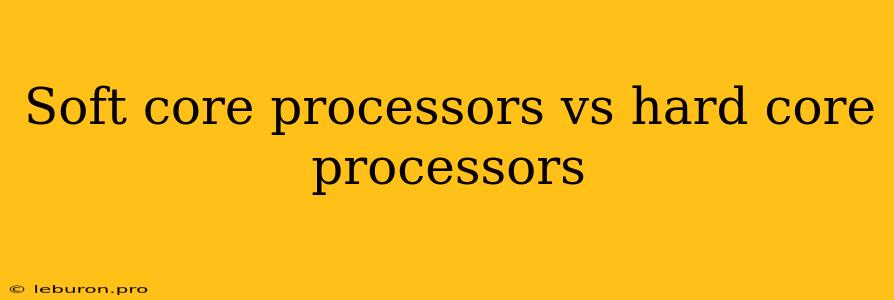The world of embedded systems is vast and diverse, with a wide range of processors designed to meet specific needs. Among these processors, two fundamental categories stand out: soft-core processors and hard-core processors. Understanding the distinctions between these two types is crucial for selecting the right processor for your embedded system design. Both types of processors have their advantages and disadvantages, impacting factors like cost, flexibility, performance, and development time. In this article, we will delve into the core concepts of soft-core and hard-core processors, explore their characteristics, and analyze their respective strengths and weaknesses.
What are Soft-Core Processors?
Soft-core processors are essentially a blueprint or description of a processor architecture implemented in hardware description languages (HDLs) like Verilog or VHDL. These descriptions define the processor's functional units, data paths, control logic, and instruction set. Unlike their hard-core counterparts, soft-core processors are not pre-designed and fabricated as dedicated chips. Instead, they are implemented within a programmable logic device (PLD), such as a field-programmable gate array (FPGA). The FPGA's reconfigurable logic fabric allows you to customize the processor's architecture and tailor it to your specific requirements.
Advantages of Soft-Core Processors:
- Flexibility: One of the most significant advantages of soft-core processors is their incredible flexibility. You can modify the processor's architecture, instruction set, and even add custom instructions to optimize it for your specific application. This degree of customization is unmatched by hard-core processors.
- Cost-Effectiveness: Soft-core processors can be implemented in FPGAs, which can be more cost-effective than using dedicated ASICs (Application-Specific Integrated Circuits) for hard-core processors, especially for small production volumes.
- Rapid Prototyping: FPGAs allow for rapid prototyping and iteration, enabling you to experiment with different processor architectures and configurations quickly. This can be invaluable during the early stages of development.
- Customization: Soft-core processors offer unparalleled customization. You can modify the processor's instruction set, add custom units, or adjust the memory architecture to meet your application's specific needs.
- Reduced Development Time: For complex systems with unique requirements, soft-core processors can significantly reduce development time compared to traditional ASIC design flows.
Disadvantages of Soft-Core Processors:
- Performance: Soft-core processors generally have lower performance than hard-core processors because they are implemented in FPGAs, which have lower clock speeds and logic density compared to dedicated ASICs.
- Power Consumption: Soft-core processors can consume more power than hard-core processors due to the overhead of FPGA fabric and routing.
- Complexity: Implementing and configuring a soft-core processor in an FPGA requires a good understanding of HDL programming and FPGA design techniques, which can be challenging for beginners.
What are Hard-Core Processors?
Hard-core processors are pre-designed and fabricated as dedicated integrated circuits (ICs). These processors have a fixed architecture, instruction set, and feature set. You cannot modify or customize these aspects of the processor. Hard-core processors are typically used in high-volume applications where performance, power efficiency, and reliability are paramount.
Advantages of Hard-Core Processors:
- Performance: Hard-core processors generally offer higher performance than soft-core processors due to their dedicated ASIC design and optimized fabrication processes.
- Power Efficiency: Hard-core processors are typically designed for power efficiency, minimizing power consumption and heat generation.
- Reliability: Hard-core processors are fabricated in dedicated ASICs, offering high reliability and stability.
- Wide Availability: Hard-core processors are readily available from a wide range of vendors, providing a variety of options to choose from.
Disadvantages of Hard-Core Processors:
- Lack of Flexibility: Hard-core processors are inflexible, as you cannot modify their architecture, instruction set, or feature set.
- High Costs: Hard-core processors are typically more expensive than soft-core processors due to the costs of ASIC design and fabrication.
- Long Development Cycles: Developing a new hard-core processor requires a significant investment of time and resources, leading to longer development cycles.
Choosing the Right Processor
The decision of whether to use a soft-core or hard-core processor depends on your specific application requirements and constraints. Consider the following factors:
- Performance: If your application demands high performance and low latency, a hard-core processor is a better choice.
- Flexibility: If you need to customize the processor's architecture or instruction set, a soft-core processor is more suitable.
- Cost: For small production volumes or rapid prototyping, a soft-core processor implemented in an FPGA can be cost-effective.
- Development Time: If you need to develop the system quickly, a soft-core processor can significantly reduce development time.
Conclusion
The choice between a soft-core and hard-core processor depends on your application's specific needs. Soft-core processors provide flexibility, cost-effectiveness, and rapid prototyping capabilities, making them ideal for applications that require customization and short development cycles. Hard-core processors offer high performance, power efficiency, and reliability, suitable for high-volume applications where these factors are paramount. By carefully evaluating your project requirements and considering the advantages and disadvantages of each processor type, you can make an informed decision that optimizes your embedded system design.
